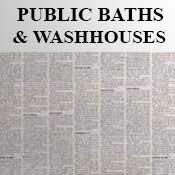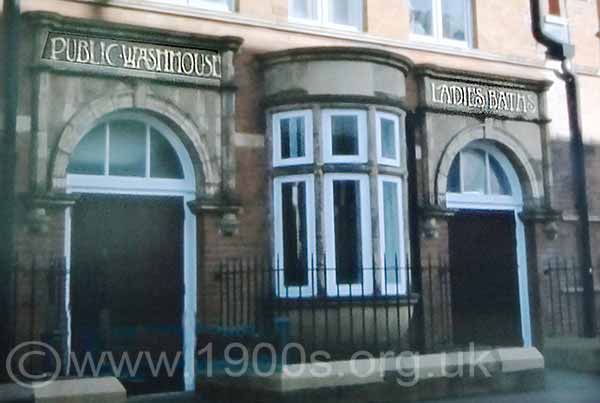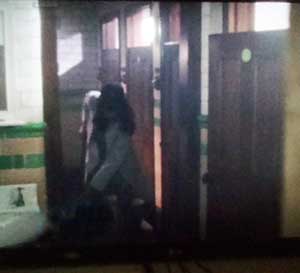
Public baths/washhouses/slipper baths

Public baths, also known as washhouses and slipper baths were popular in the past when people did not have baths or bathrooms at home. This page explains, and goes on to describe payment for a bath and the system of cleanliness and hygiene: the cubicles, hot water, clean soap and towels. Highlights are the personal experiences of these baths contributed by people who actually used them.
____
Extracted from the memoirs of the webmaster's mother(1906-2002) and edited by the webmaster with further research and firsthand contributions from others
In the early years of the 20th century and before, it was common for older homes not to have baths or to have baths without a water supply. So there were public baths which enabled people to have a bath. These were also known as washhouses and slipper baths.

Old public baths building. The writing over the left hand door is Public Washhouse. Over the right hand door is Ladies. So the sexes were, not surprisingly, separated.
Although 'Public Washhouse' is carved over this lintel of this particular public baths, I also saw the inscription 'Slipper Baths' on some buildings. I have no idea of the origin of the name.
The experience of public baths in the mid-late 1940s
When I went into the public baths in 1940s, I would take clean vest, pants and socks with me to change into after my bath, and take the dirty ones home with me to be washed. It was common practice in those day to change one's underwear only once a week.
Payment for a bath
Through the main door was a pay kiosk where you could buy a ticket for a private bath cubicle. A first class ticket cost ninepence or a second class ticket cost sixpence. The tickets had a number on. The differences were that the first class cubicles were separate from the second class ones and you got two towels instead of one plus a scoop of bath salts (effectively washing soda that was supposed to reduce the scum produced by soap in hard water). The second classes were given only one towel. I paid sixpence.
The soap
Both classes were given a small piece of soap which was green and hard, and which produced very few bubbles. You could see that it had been cut from a large block. That's all there was during the war. There was no such thing as toilet soap.
This green soap was also used to wash hair as there was no shampoo available during rationing years. If you got this soap in your eyes it made you cry with the pain. It was only after rationing ended that fancy smelling soaps came back into the shops. A little later shampoo appeared, but many people continued to use ordinary soap as I did up to 1954 in the army.
The attendant would collect any small pieces of soap that were left in the cubicles. It was common knowledge that these pieces were melted down in a pan over a gas ring and re-cycled into 'new soap'. Most people took these pieces of soap home with them. My mother would melt them down, pour the liquid soap into a fairy cake tray and then use this soap to wash our clothes. The common saying at that time was "waste not want not".
The waiting areas: separate benches for first and second class
Up the stairs were separate benches for the first and second classes. There you sat and waited for the number on your ticket to be called which meant that a bath was free for you.
The baths and the hot water
The bath was a giant rolled top iron one that you could float in. The water was piping hot and the whole building was filled with steam and the sounds of men singing in their baths.
Emptying the bath water
There were no plugs in the bath. The attendant turned a knob on the outside wall to empty it through a piple. This prevented anyone from continually running in fresh hot water. When you had finished, you called out your cubicle number and the attendant opened the tap to let out the water, and once you had gone, cleaned the bath ready for the next occupant.
When you came out afterwards into the fresh air, you felt on top of the world and about 5 lbs lighter.
Peter Johnson
The experience of public baths in the late 1950s
My experience of public baths comes from the late 1950s when my wife and I lived in a caravan, during the first two years of our marriage.
As my childhood experience was that 'bath time' was a period before one went to bed, it was rather strange to go outside for a bath often in the afternoon.
Our public baths were in a large building in Epsom. On entry, you paid your two and sixpence* to a man sitting in a kiosk. He would issue you with a numbered ticket for an empty cubicle, in much the same way that cinema tickets were dispensed. He would also pass you a rolled up towel and a small rectangular tablet of red carbolic soap.
You then entered a large vaulted hall, somewhat similar architecturally to a railway station. Throughout this hall were cubicles in which were baths.

This unfortunately rather poor photo shows the numbered bath cubicles inside a public baths
There was a quite separate ladies section, which was entered through a different door from that of the men's section.
You would enter your cubicle, shut and bolt the door, run your bath, undress and hang up your clothes, and take your bath. The water was hot and plentiful, but I seem to remember that during the war, you were only allowed 4 or 5 inches of water in the bath.
Having had your bath and dried and dressed yourself, you would leave the establishment, depositing the towel in a large basket with all the other used towels. You might well pass a 'gentleman of the road' whose tattered and slightly dirty clothes would look somewhat at variance with his pink, shiny, well washed face. I never thought about who cleaned the bath after him - or me. I don't suppose that there was any difference between my dirt, and his, although perhaps mine was just a little 'younger'. Anyway, my bath was always spotless when I used it, so there must have been a 'resident' cleaner.
Dick Hibberd
*On reflection, two and sixpence seems a bit steep, so maybe he was misremembering. [In view of the previous contribution, I think he was - webmaster.]
Later in the century, many people were still living in older properties, and many were bombed out from the air raids of the Second World War and living in temporary accommodation. They, too, were glad of public baths.
If you can add anything to this page or provide a photo, I would be pleased if you would contact me.
Text and images are copyright
sources: early 20th century material
sources: ww2 home front and other material
contact
the webmaster/author/researcher/editor
privacy policy
















